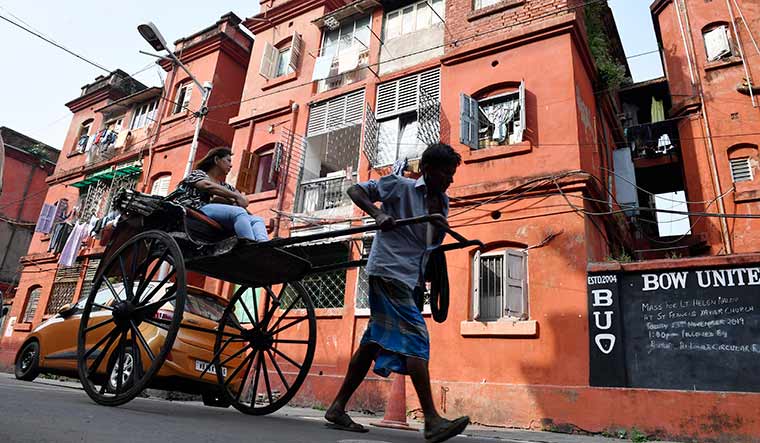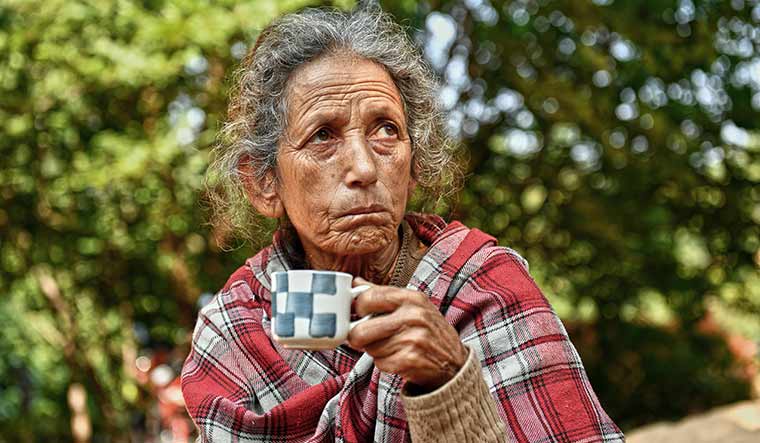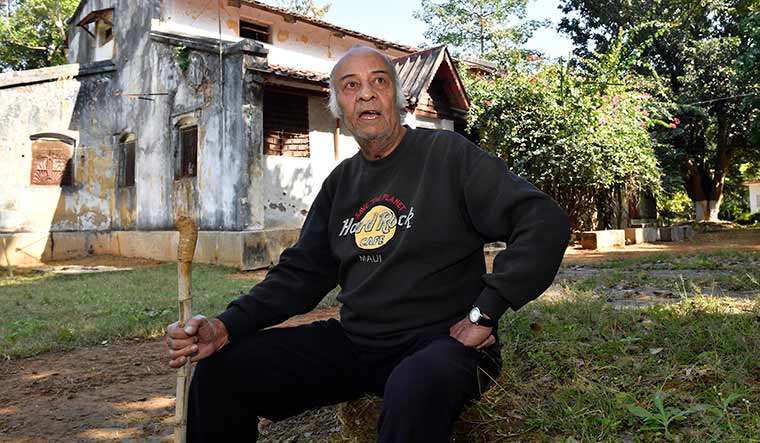The quaint, old, colonial style house, surrounded by trees and a small garden, offers a welcome calm from the city’s chaos. And, its residents exude warmth, despite us committing the cardinal sin of dropping in unannounced on a lazy Sunday noon.
It is home to elderly sisters Shirley Davis and Mabel Scolt, and is among the very few traditional Anglo-Indian homes that have stood the test of time in Whitefield, once a designated settlement for the Anglo-Indian community in Bengaluru. In 1882, King Chamraja Wodeyar IX, the Maharaja of Mysore, had granted 3,900 acres to the Eurasian and Anglo-Indian Association for the establishment of an agricultural settlement. Named after David Emmanuel Starkenburgh White, the association’s president, Whitefield was a quaint little town until the early 1990s when it was absorbed almost completely into Greater Bangalore.
Today, there are hardly any traditional Anglo-Indian houses in Whitefield; the skyline is dotted with tall buildings housing IT firms. Families have either migrated or simply ceased to exist with the last of their members dying.
Outside the sisters’ home, Davis’s grandson, Sean Lawrence, 40, is busy painting the roof tiles that had come off over the years. Working on the tiles is part of his plan to conserve the ancient family home.
Inside, Davis, 86, has just finished making rose cookies, a traditional Anglo-Indian sweet, and is prepping for lunch with Scolt, 76. Davis’s daughter, Judy Lawrence, is busy with chores in her part of the residence within the compound. The interesting cohabitation of the Davises, Lawrences and Scolts is a perfect example of an Anglo-Indian family in modern India, trying to balance the past with the present and being watchful of the future.
Davis and Scolt, who still teach English to neighbourhood children, list several Anglo-Indian families who lived in Whitefield. “Very few are left now,” says Davis. “Most moved away and the elders passed away. We decided to stay on. This is the home we know.”
Home is a concept the community has struggled with since India’s independence. Many Anglo-Indians—people with mixed Indian and European ancestry—left for their fatherland in the 1940s and 1950s. Later, the Indian Constitution made special provisions to safeguard their interests, one of which was political representation for Anglo-Indians in the Lok Sabha and legislative assemblies. In December 2019, the Union government scrapped the quota, triggering a sense of uncertainty within the community.
Anglo-Indians, however, have been worried for long about their future owing to dwindling numbers. Take, for instance, the sleepy town of McCluskieganj in Jharkhand. It was established in 1933 by the Colonisation Society of India as a settlement for Anglo-Indians on 10,000 acres of forest land, given by Raja of Ratu, and was named after businessman Ernest Timothy McCluskie. A huge British-styled bungalow on a sprawling campus stands forlorn in the middle of what was once a major Anglo-Indian settlement. The only residents today on the campus are the caretakers and Brian Mendies, 80, who stays in an outhouse.
Mendies agrees to speak to us only because we are accompanied by Sandeep Razdan, a popular local. Mendies arrived in McCluskieganj in 1940 as a one-year-old with his parents, grandfather and extended family. Instead of living with his two daughters in Dehradun, he prefers the seclusion of McCluskieganj and wants to die and “have his bones buried here” because his wife, a son and a daughter were laid to rest here.
The bungalow, known as Christineson bungalow, was originally owned by his father, Harry, says Mendies. It was later sold to one Lucas, who gifted it to his sister, Mrs Christineson. Mendies’s daughter Yvonne married Christineson’s son Bryan. While Mendies sold his own property in McCluskieganj and moved into the outhouse. “I have lovely memories associated with this house and this town,” he says. “We had a great time eating the traditional delicacies our mother cooked, attending get-togethers and playing badminton at the local club, running around in the fields and having picnics and hunting expeditions at Dulee (a nearby village). I have seen tigers and panthers here and lots of other animals. It was a veritable forest. Ganj is still green, but it has certainly changed a lot.” The biggest change though has been in the number of Anglo-Indians staying here. “From over 200 families at one time, we now have no more than 25-30 people, not families, staying here,” he rues.
A little distance away, in a small home, surrounded by orchards, lives the ‘face of McCluskieganj’—Catheline ‘Kitty’ Texeira. ‘Aunt Kitty’ has been the most featured person in stories on the settlement. But the fame has done little for the 69-year-old, who was born here. Since the age of 11, Kitty has been struggling to make ends meet. She would walk about 3km twice a day to sell fruits at the railway station. She still sells fruits, though from home, and also rears goats. “Ganj is going down,” she says with a faraway look in her eyes.
The downward spiral is visible in almost all Anglo-Indian settlements. The only exception, perhaps, is Bow Barracks, located in the heart of Kolkata. Seventy per cent of the 132 families that reside in its red-brick apartment blocks are Anglo-Indians, says Angela Govindraj, secretary of the Bow Barracks Residents’ Welfare Association. Built by the British as military housing almost a century ago, Bow Barracks is one of the few surviving clusters of Anglo-Indians in the country. In the recent past, it faced the threat of demolition. But Govindraj says that the Kolkata Municipal Corporation has decided to declare it a heritage site; conservation work is expected to start soon.
But rather than Bow Barracks, it is the situation in the once-thriving settlements of McCluskieganj and Whitefield that better describes the condition of Anglo-Indians in India. The community does not live in clusters anymore, and is scattered across the country and abroad. But wherever they are, they continue to live a spirited life, imbibing the Indian way of life even while staying true to their culture. Initially, their proficiency in English got them jobs in the railways, and in schools as teachers. But now they have diversified.
There is no denying the fact though that their numbers have declined. The main reasons are intercommunity marriages, owing to which children of Anglo-Indian women who married outside the community are not considered Anglo-Indians, and emigration of young Anglo-Indians since independence. Community leaders hesitate to give an exact figure, putting it “somewhere around 4 lakh” to “a few lakhs” at best.
Several Anglo-Indians take umbrage at the perception that the community is dying or their numbers dwindling. “We should be very careful about the choice of words,” says Kolkata-based octogenarian Melvyn Brown, a chronicler of the community. “The community is rather scattered and not living in clusters and that is the only point.”
Creative director of June Tomkyns chain of hair salons, Priscilla Corner, says that the community is, in fact, growing because of globalisation and intercommunity marriage, though in a different format as many are not born in India. “But by the way of blood lineage, we are certainly a growing community,” she says.
The 2011 Census, however, puts the number of Anglo-Indians in the country at 296, a figure that has shocked community members. Now, with the Union government deciding against extending the constitutional provision for nomination of Anglo-Indians to Lok Sabha (two seats) and the state assemblies (one seat), their political reservation comes to an end on January 26, 2020. This, despite protests against the move from the community. The reasoning behind the decision apparently was that since the community was doing better now, it did not need political reservation.
Former nominated member of the Madhya Pradesh Legislative Assembly Loren Lobo, who terms the move as “very sad and unfortunate”, says there is no constitutional basis for the reservation to be discontinued. Former member of parliament Dr Charles Dias calls the government’s decision an “injustice and cruelty to the community”. He cites the various problems the community faces, as highlighted in a 2013 report by the ministry of minorities—from unemployment to housing issues and lack of higher education. “So the logic of the community being well-off now does not work,” says the Kochi resident.
Despite the problems plaguing the community, it has found ways to thrive. For instance, in McCluskieganj, former member of Jharkhand assembly Alfred George de Rozario opened a school—Don Bosco Academy—in 1997, which led to economic opportunities for the members of the community and others—some opened hostels, others preschools and bridge schools. It also brought back some people like Malcolm James Hourigan, who had left town owing to lack of opportunities. He returned to McCluskieganj in 2007 after doing a series of non-teaching jobs with private schools in different states, and now runs a hostel and bridge school mainly for tribal children.
Though there is a general perception, even among community members, that Anglo-Indians tend to have a ‘eat, drink and be merry’ attitude, without giving a thought for the future, most community leaders say that there is a change in the mindset. “There are many more graduates now and they are landing good jobs and coming up in life. But many are also leaving the country, fascinated by the opportunities abroad,” says Brown.
Agrees Bengaluru resident Shirley O’Leary, who says that earlier youngsters did not pursue higher education as their families expected them to start earning once they were old enough. But, Vivienne D’souza did not let the epicurean perception of her community deter her from doing her MBA from XLRI, Jamshedpur, in 1973. She had a successful career in banking and now runs a corporate training company in Bengaluru. “Being an Anglo-Indian does not automatically mean you are easy-going,” she says. “It is just that some people choose to see it that way and want to justify not succeeding.” Also, Quinton Doll, 30, a school teacher from Pune, says that Anglo-Indians were streotypically seen as only railway employees or teachers. “But social media has brought in opportunities for inclusiveness and assimilation,” she says. “Also, knowledge of English brings respect and society does look up to you.”
Anglo-Indians, however, do know how to make merry and also hold on to their culture and traditions, be it through their food, music, dance or attire. Traces of their culture have been caught for eternity in family photographs, and handed down through heirlooms, furnitures, cutlery and religious icons.
“Anglo-Indians are very open-minded and hospitable people with very strong emphasis on religious and family values,” says Ursula Fosberry, president of the Anglo-Indian Guild, Bengaluru. “Everyone likes to be together for religious or social occasions.”
Lin Ann Dlima, a Jabalpur-based lawyer, says that Sundays or holidays are very much reserved for family get-togethers as are occasions like birthdays and anniversaries. “Along with traditional food, it is also time for music and dance and having fun,” she says.
Fosberry says that though Indian dishes have made their way to Anglo-Indian dining tables, there is still enough hint of traditional food in their meals. Breakfast is porridge or bread, butter and omelette with fruits and juices, though there are days of dosas and idlis, too. Lunch is usually Indian—rotis, rice, dal, veggies, fish or any other non-vegetarian dish. Dinner, however, takes on a more European touch with bread, chicken roast and mashed potatoes. Then there are special dishes like meatball curry, stew, cutlets and roasts and typical sweets like ‘Matrimony’ (a coconut-cashew barfi), says Davis.
To further retain their culture, the community is leaning towards more intracommunity marriages. A marriage bureau run by the Anglo-Indian Guild has helped conduct 10 such marriages in the last four years, says Fosberry. Gilbert Faria, president of the Anglo-Indian Welfare Association, Delhi, who insisted on getting his daughter married to an Anglo-Indian, says, “Though the matches are difficult to find, mainly due to higher education among girls, efforts are still made in the direction.”
Retired rear admiral Alan O’Leary, 67, who still travels around his Cooke Town residence in Bengaluru on a scooter with wife Shirley, 66, sums it up best: “Though a lot of our kin and people we know have left the country and done quite well for themselves, some wished they had never left their native shores as they longed for the days gone by, though it is no longer a reality. As for us, we are very comfortable in India. We are Indians at heart and we like our independence, our kind of music, our kind of cuisine and, overall, our kind of life.”






